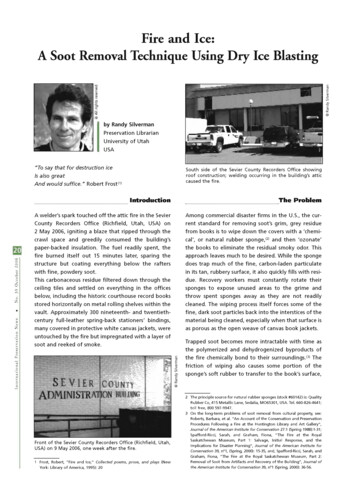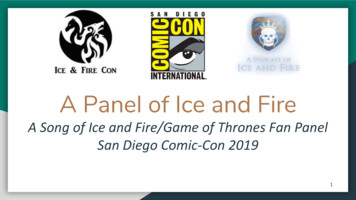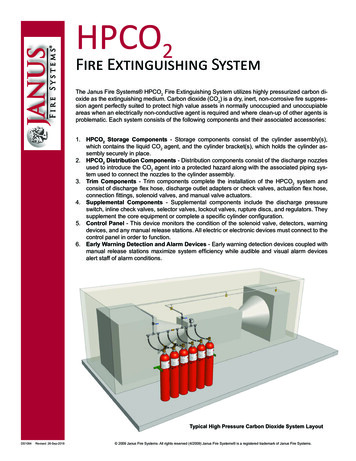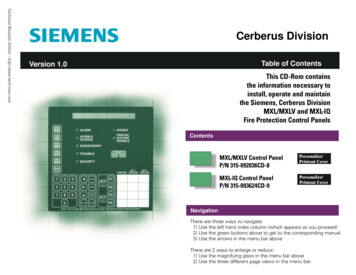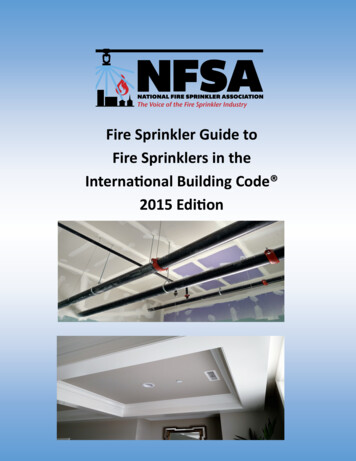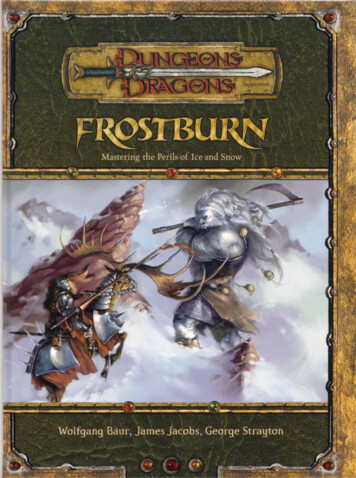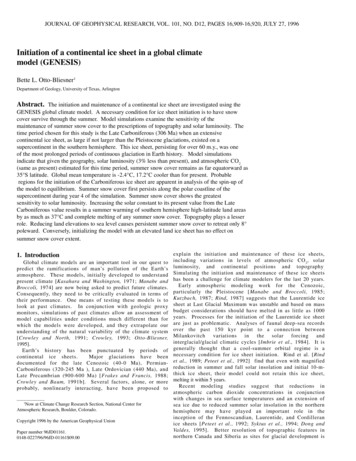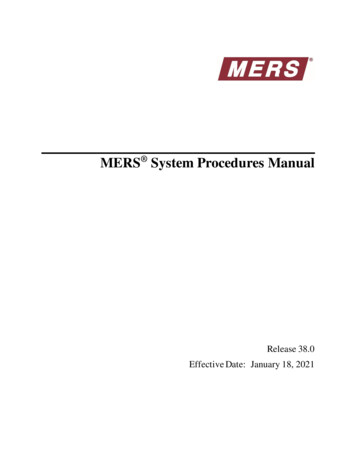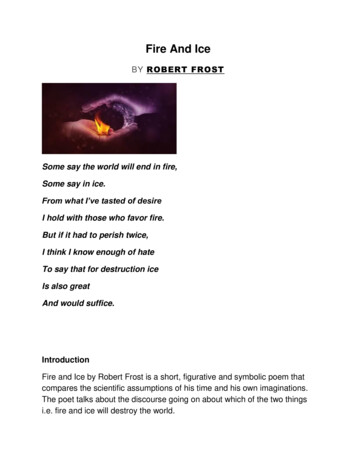
Transcription
Fire And IceBY ROBERT FROSTSome say the world will end in fire,Some say in ice.From what I’ve tasted of desireI hold with those who favor fire.But if it had to perish twice,I think I know enough of hateTo say that for destruction iceIs also greatAnd would suffice.IntroductionFire and Ice by Robert Frost is a short, figurative and symbolic poem thatcompares the scientific assumptions of his time and his own imaginations.The poet talks about the discourse going on about which of the two thingsi.e. fire and ice will destroy the world.
The Central Idea Of the Poem:The poem "Fire and Ice" by Robert Frost is about the hypothetical end ofthe world, with the speaker asserting that it will be destroyed eitherby fire or by ice. One could argue, though, that the central idea ofthis poem is that fire and ice are equally destructive, in their own ways.The central idea around which the entire poem revolves is that only love,equality, mutual understanding and sympathy for one and all can help inestablishing peace on the Earth. The poet mentions that both fire and iceare probable ends of this world. While he talks about how fire representsdesire and can, therefore, be a cause of the end of the world, he alsomentions ice in between to symbolize that the coldness and indifferencetowards one another will also be enough to end the world.Fire and Ice : Poem MeaningFor the poet, fire means the burning desire for the material thingsand ice means coldness that emerges in humans because of the desiresand materialistic life. He finally concludes that both of these weapons areequally dangerous and will lead the world towards destruction.This short poem comprises of nine lines and has rhyme scheme aba abcbcb. There are three sentences. In the first sentence, the poet explains thepopular debate that is prevailing in the society since long about what willdestroy the world.In the second sentence, he metaphorically changes the discourse. Now fireand ice mean something deeper and profound. in the final line, which is thelongest, he gives his own thoughts.Part IThe poet begins the poem by narrating the popular and age-old debateabout the two things out of which one will destroy the world. These twothings are fire and ice.
Some scientists believe that it is the fire that will be responsible for thedestruction of the world. The fire here means the lave which is in the coreof the earth.People believe that someday, the earth will burst and there willbe huge explosions of fire that will burn the world and hence everything willbe destroyed.The other belief is that it is the ice that will destroy the world. Now, ice mayrefer to different things (as I have read different interpretations of this wordin various sites). First, ice probably refers to melting of glaciers and rising ofsea-level in which everything will sink.However, this interpretation does not seem to be the exact meaning ofwhat Frost talks about. The other interpretation of ice is the entering of ameteor or any other thing from the space which will stop the sunlight andhence, there will be an ice age which will make the world perish.Whateverthe meanings of fire and ice are, the poet gives a popular assumption of histime.Part IIIn the next line, the poet comes to his own interpretation of these twoterms. According to him, he has tasted desire and hence he is of thethought that those who favour fire are right and he supports their view.Desire is what led Adam and Eve to eat the fruit of the forbidden tree. It isthe desire which makes the people greedy, materialistic and deceitful.It is the desire for power that led the deadliest wars, battles and costan uncountable loss of humans as well as other living things. Hence, for thepoet, the fire of desire will destroy the world.
Part IIIBut, the poet says that if the world were to destroy twice ice would alsohave destroyed it. Ice, in the words of Frost, refers to coldness in therelation. With the emergence of materialistic thoughts, emotions andhuman warmness have vanished away.In the race of worldly things, peoplehave forgotten other humans and have started loving material things. Thusfor the poet, the hate which has emerged because of desire would alsohave destroyed the world if it were had to perish twice.Note how the poet has brought two different things together. Ice and firecannot be there at the same time. But for the poet, desire (fire) is whatleads to coldness (ice). Hence both will be there to destroy the world in thefuture.Summary And Analysis of the Poem‘Fire And Ice’ is a short poem by Robert Frost. In this poem, the poet refersto two predictions of how the world will end. He presents two oppositeviews about the end of humanity and the world. He discusses these twopossibilities which will be the reason for the end of the world. One suchpossibility is the world ending in flames of fire. It is so, because when heponders over the burning flames of desires of people. These will definitelyhurl the world into another nuclear war, and hence it will burn up the entireworld in flames. The second possibility for the end of the world is due to theice.The poet has a strong feeling that people have so much hatred in theirhearts against each other that it will be sufficient to freeze the entire planettowards death. So, the fire due to evil desires and ice of wicked hatred arethe two opposite opinions enough to destroy the world.
The poet is very much sure of the destruction of humanity on someday. Heis talking about the two different beliefs regarding the end of this world.These are on the basis of the sayings of the people. The poet says that heis in favour of those people who say this world will end in fire. This isbecause he has seen the effect and result of uncontrolled and unendingdesires over the life of human beings. He finds that human evil desires aresimilar to the fire in its nature. So this fire may become a big reason todestroy humankind and this world too.On the other hand, the second belief in this regard says that ice is alsosufficient for destroying this world. Here the poet compares the nature ofice with hatred feelings of humans with the other humans. As ice can makethe body numb with its prolonged contact, similarly hatred can also give thenumbness to our mind and thoughts. And hence it can make us insensitiveand cruel. Such cruelty towards humanity will be more responsible for thedestruction of the world compared to the desire.The speaker brings us all into the middle of the argument between twodifferent categories of the people. One who thinks that the world will cometo a fiery end and other people who think the world will freeze resulting tothe end. Poet is possibly talking about the literal end of the world. But he isalso talking about the power that human beings have to destroy each other.The poet experiences the romantic desire that he has taught the passionfor emotions like love and lust. These will probably have the power to turnthe earth into a big fireball. But he has also experienced the other extremeside. This is about colder emotions like hate which have great destructivepower. It is a common fact that love gets all the publicity, whereas hate isthe silent killer. It may not have the same effect as the fireball ending, but itwill do the trick.
Key points The poem has been written symbolically. The poet says that there are mainly two opinions about the end of thisworld, one by fire and another by ice. The symbols-‘Fire’ and ‘Ice’ have been used for human emotions likedesire and hatred respectively. As fire can spread very fast and cause a great destruction in no timelikewise our desires may also prove very destructive if they go out ofcontrol. Hatred causes slow destruction like ice but it is also very harmful.Analysis of Literary Devices in “Fire and Ice”Robert Frost has used some literary devices in this poem. The analysis ofsome of the literary devices used in this poem is given below:1. Assonance: Assonance is the repetition of vowel sounds in the sameline such as the long sound of /o/ in “I hold with those who favor fire”.2. Alliteration: Alliteration is the repetition of consonant sounds in thesame line such as the sound of /f/ in “I hold with those who favor fire”.3. Imagery: Imagery is used to make readers perceive things involvingtheir five senses. For example, “Some say the world will end in fire” and“To say that for destruction ice, is also great”.4. Symbolism: Symbolism is a use of symbols to signify ideas andqualities, by giving them symbolic meanings different from their literalmeanings. “Fire” is the symbol of desires and “Ice” symbolizes hatred.Similarly, “green” and “gold” are the symbol of beauty and happiness.5. Anaphora: It refers to the repetition of a word or expression in the firstpart of some verses. For example,“Some say the world will end in fire,Some say in ice.”
6. Personification: Personification is to give human qualities to inanimateobjects. In this poem, “Fire” and “Ice” are capable of destruction.Therefore, the poet personifies fire and ice by giving them a mind whichis capable of destroying almost anything.7. Enjambment: It is defined as a thought or clause that does not come toan end at a line break; rather, it moves over the next line. For example,“From what I’ve tasted of desireI hold with those who favor fire.”Conclusion :The poem is revolving around the theme that human emotions aredestructive, and has two possible forms.Short questions and answersQ1: What are the two opinions discussed in the poem about the end ofthis world?A: The two opinions are that this world will end either in fire or in ice.Q2: What does fire stand for in the poem?A: Fire stands for desire as it spreads very fast if remains uncontrolled.Q3: What does ice stand for in the poem?A: Ice stands for hatred as both are same in nature, they make usinsensitive and rigid.Textbook questions & answersQ1: There are many ideas about how the world will ‘end’. Do you think theworld will end some day? Have you ever thought what would happen if thesun got so hot that it ‘burst’, or grew colder and colder?A: Yes I believe that this world will end some but when nobody knows.
Whether the sun gets hot or it gets colder in both the situations end of thisworld is sure.Q2: For Frost, what do ‘fire’ and ‘ice’ stand for? Here are some ideas:# greed # avarice # cruelty # lust # conflict # fury # intolerance# rigidity # insensitivity # coldness #indifference # hatred.Ans.FIRE: greed, avarice, lust, conflict, fury, intolerance.ICE: cruelty, rigidity, insensitivity, coldness,indifference, hatred.Q3: What is the rhyme scheme of the poem? How does it help in bringingout the contrasting ideas in the poem?A: The rhyme scheme of the poem is: aba, abc, bcb. The twocontrasting ideas fire andice are totally supported by the rhyme scheme ofthe poem as different alphabets carry different ideas which are expressedin the poem.The poet has presented two opposite views about the end ofthe world. The poet discusses the two possibilities regarding the end of theworld. One possibilities is the world ending in flames of fire. The poet feelsso when he ponders over the burning flames of desires of people. Thesedesires for more money, more power, etc. will surely hurl the world intoanother nuclear war, which will burn up the entire world in flames.The second possibility of the doom of the world is with ice. The poet feelspeople have so much of hatred in their hearts against one another that it issufficient to freeze the entire planet to death.So, the fire of evil desires and ice of wicked hatred are the twocontradictory opinions presented in the poem Fire and Ice by Robert Frost.***********************************
Fire and Ice by Robert Frost is a short, figurative and symbolic poem that compares the scientific assumptions of his time and his own imaginations. The poet talks about the discourse going on about which of the two things i.e. fire and
